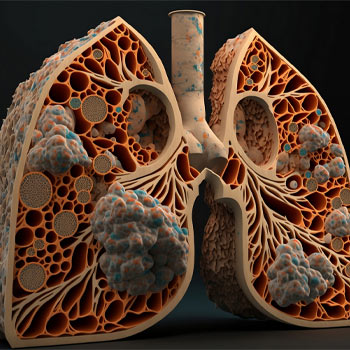Interstitial lung diseases
- Home
- Services
- Pulmonology
- Interstitial lung diseases
What is Interstitial Lung Diseases?
Interstitial lung diseases (ILDs) encompass a diverse group of disorders characterized by inflammation and fibrosis (scarring) of the lung tissue between and supporting the air sacs (alveoli). These conditions affect the interstitium, a thin layer of tissue surrounding the alveoli where gas exchange occurs. ILDs can lead to progressive lung damage and impaired respiratory function. Understanding the causes, symptoms, diagnosis, and treatment options for ILDs is crucial for effective management and patient care
What are the main reasons for Interstitial Lung Diseases?
Interstitial Lung Diseases can arise from various causes, including
- Environmental Exposures: Inhalation of asbestos fibers, silica dust, and other environmental pollutants can lead to ILDs such as asbestosis and silicosis
- Autoimmune Disorders: Conditions like rheumatoid arthritis, systemic sclerosis (scleroderma), and lupus can cause ILDs through autoimmune-mediated inflammation
- Medications: Some drugs, such as certain chemotherapy agents and antibiotics like nitrofurantoin, can induce ILDs as a side effect
- Infections: Chronic infections like tuberculosis and fungal infections can lead to ILDs, although this is less common
- Idiopathic Causes: In many cases, the exact cause of ILDs remains unknown (idiopathic interstitial pneumonias)

What are the typical symptoms associated with Interstitial Lung Diseases?
Symptoms of ILDs can be nonspecific and vary depending on the specific type and severity of the disease. Common symptoms include
- Progressive Dyspnea (Shortness of Breath): Often the earliest and most prominent symptom, worsened with exertion
- Dry Cough: Persistent and often unproductive, lasting for weeks to months
- Fatigue and Malaise: Due to decreased lung function and impaired oxygen exchange
- Clubbing of Fingers: In some cases, the fingertips may appear rounder and wider than normal due to chronic oxygen deficiency
What methods are used to diagnose Interstitial Lung Diseases?
Diagnosing ILDs involves a comprehensive evaluation, including
- Medical History and Physical Examination: Assessing symptoms and risk factors
- Imaging Studies: High-resolution computed tomography (HRCT) scans can reveal characteristic patterns of lung damage
- Pulmonary Function Tests (PFTs): Assess lung capacity and function, revealing restrictive ventilatory defects common in ILDs
- Biopsy: Invasive procedures such as surgical lung biopsy or bronchoscopy with biopsy may be necessary to confirm the diagnosis and determine the underlying cause
How can Interstitial Lung Diseases be treated?
Management of ILDs aims to alleviate symptoms, slow disease progression, and improve quality of life. Treatment options include
- Medications: Corticosteroids and immunosuppressive agents may help reduce inflammation and fibrosis in certain ILDs
- Oxygen Therapy: Supplemental oxygen can improve oxygen levels in the blood and relieve symptoms of hypoxia
- Pulmonary Rehabilitation: Exercise programs and breathing techniques can enhance exercise tolerance and lung function
- Lung Transplantation: In severe cases of progressive ILDs, lung transplantation may be considered for eligible patients
What can be expected in terms of recovery for Interstitial Lung Disease?
The prognosis for Interstitial Lung Diseases varies widely depending on the specific type and extent of lung involvement, as well as the promptness of diagnosis and initiation of appropriate treatment. Some ILDs progress slowly over years, while others may have a more rapid decline in lung function. Regular monitoring and follow-up with healthcare providers are essential for managing ILDs and optimizing long-term outcomes
understanding the complexities of interstitial lung diseases is crucial for healthcare providers and patients alike. Early recognition, accurate diagnosis, and timely intervention are key to improving outcomes and enhancing quality of life for individuals living with ILDs. Research continues to advance our understanding of these diseases, offering hope for improved therapies and better outcomes in the future.
